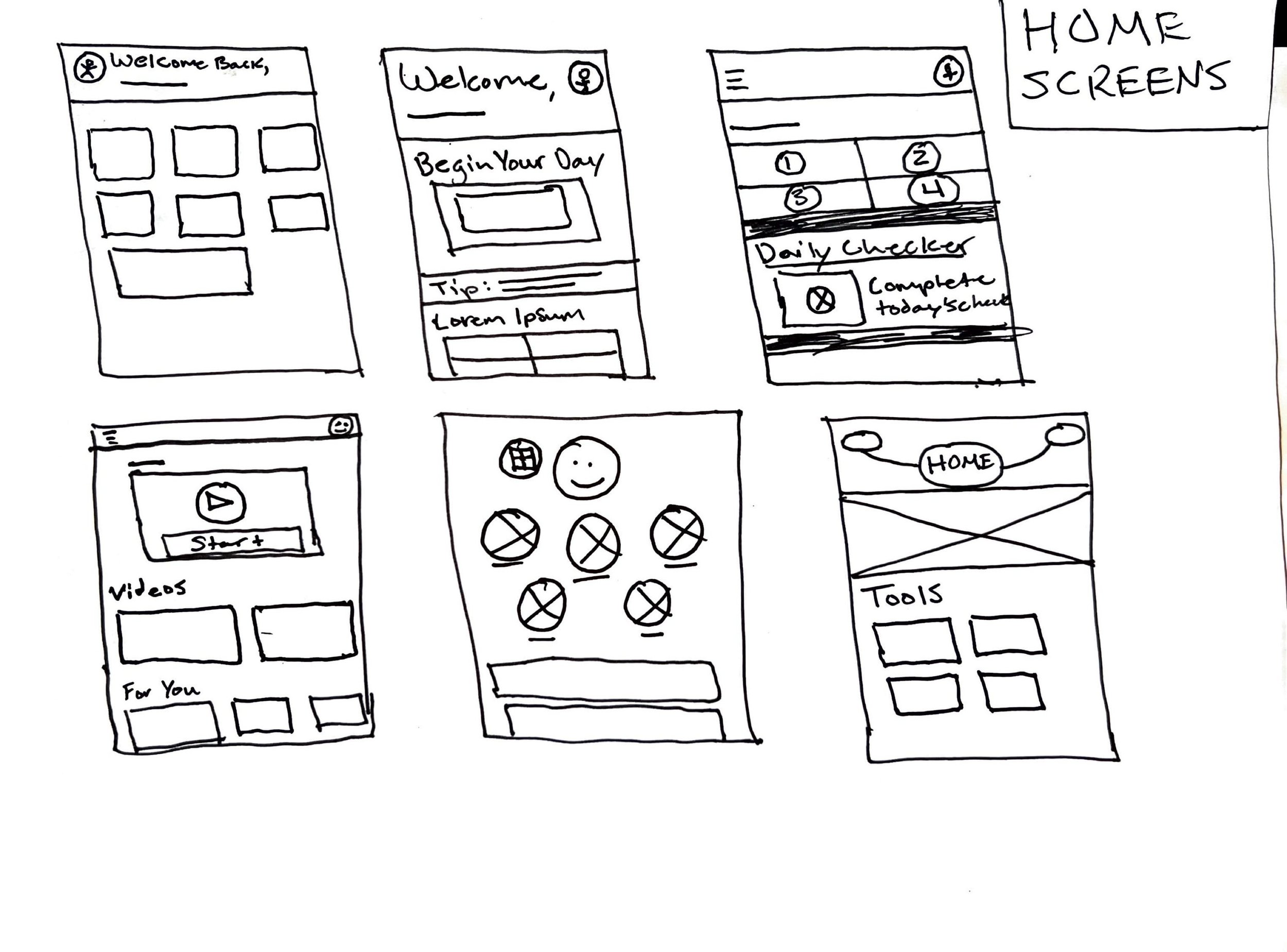
Heroes of New Orleans
Non-Profit Organization to reduce recidivism in teens and young adults
FEBRUARY 2023 - SEPTEMBER2024
Available for Website and IOS App usage
-
Available for Website and IOS App usage -

Heroes of New Orleans is a non-profit focused on reducing poverty and violence among local youth by increasing positive behavior and attitudes. It needs a tool to encourage positive behavior, offer opportunities to better oneself, and check in with all youth members
ROLE
UX Designer & Researcher in collaboration with SCANLAB
TIME
7 Months
PROCESS
Conducting interviews, paper and digital wireframing, low and high-fidelity prototyping, conducting usability studies
TOOLS
Figma, Adobe XD, Qualitrics,
Overview
Challenge
New Orleans has become the #1 murder capital of the U.S., which also consists of underage criminal activities. Leaders and citizens of the community want a way to reduce criminal activity and support troubled youth with little to no privilege. It is hypothesized by lab researchers working closely with the non-profit that stress could be a major contributor.
Non-profits heavily depend on support from their local communities and donors, sponsors, grants, and fundraisers. Apps and responsive websites are more likely to increase financial donations and allow people from the community to easily RSVP to volunteer for events.
Ideal Goal
Design a tool to accompany youth members and provide access to online learning material, the ability to RSVP for events, and lead a more successful future.
Methods
Conducting interviews, Quantitative and Qualitative research, paper and digital wireframing, low and high-fidelity prototyping, conducting usability studies, accounting for accessibility, iterating on designs, determining information architecture, and responsive design.
Approach
We focused most of our research on interviews and existing studies on habits and exercise. By developing archetypes, we established the exercise's main motivators and constraints and focused our app on accountability. We then proceeded to prototype and test our ideas.
-
Research
-
Strategy
- Research - Strategy
Importance
How bad is crime in New Orleans?
On July 30, 2022, New Orleans ranked #1 murder capital with a rate of 36.8%, which was the nation’s highest homicide rate
How bad is juvenile delinquency in New Orleans?
In early 2023, there was a 40% increase in juvenile homicide. In addition, a significant amount of juveniles were arrested for concealing illegal firearms, affiliating with gang activity, and carjacking. Recidivism rates in juveniles began to increase in 2024.
Summary
There aren’t many effective programs working with juvenile offenders, but Gregory Ravy, CEO, founded Heroes of New Orleans to work closely with adolescents facing adversity. Mr. Ravy partnered with the SCANLAB of UNO, allowing our team to conduct ethical and professional research. SCANLAB is known for studying the effects of stress. Mr. Ravy approached me about making a tool for youth members that would holistically improve the achievement of young professionals in career path exposure and educational attainment.
User Testing and Approach
Participants
For this, we gathered 20 participants currently in the program and 20 who are guardians or known to support and attend events.
20 participants are adolescents enrolled in the program who have or are struggling with delinquent behavior, troubled home life, or adversity.
15 participants are related to a member (parents, grandparents, cousins, or close family member)
5 participants are Donors, CEOs, or Sponsor
NOTE: Since members are under 18, each participant was present with their guardian and signed a confidentiality form.
Methodology
Since our primary focus is increasing the consistency of adolescents committed to the program, we decided to interview program members to understand their problems at home. We also want to give them a voice and hear their concerns and ideas, which will help them stay on the right track.
We used mixed methods research, both qualitative and quantitative data.
survey on stress
their opinion of why a high level of adolescents are involved in crime
what would they suggest as a solution to this issue
Interview going over their responses
Do you feel stressed or angry on a daily or frequent basis?
Do you feel as involved as you'd like to be?
Interpretation: My primary and secondary research shows a dose-response relationship between ACE scores and physical/mental health. ACE stands for “Adverse Childhood Experience.”
This means physical health deterioration and mental sabotage, such as doing things you know to be wrong (drugs, violence, mental health).
Giving adolescents living through adversity a tool to have a voice can allow them to change bad habits.
Somewhat all participants agreed that this is a contributing factor of bad behavior.
Interpretation: High levels of adversity cause your brain and body’s stress response system to release cortisol and fight or flight activation. When adolescents continue to have this stress response activated daily, it affects the area of the brain associated with learning, and they're more likely to engage in high-risk behavior.
One adolescent participant quoted the following:
“Sometimes I want to talk to someone about my environment, but eventually, I change my mind or forget it.”
Almost all participants agreed that this is a contributing factor to bad behavior.
Interpretation: Adolescent members feel like they’re making progress but being away from the program makes it harder to stay on the right path. Almost all participants wish they had access to the programs course material during these vulnerable moments. 90% of participants, adolescents, gurdians and donors reported they think they can be more involved if there was more options.
Do you live in a bad environment? (school, social or home life)
Notes for Design Phase
Based on our findings from the research
Members need 24/7 access to educational material, online advocacy, and event opportunities
Volunteers want to be more engaged with what’s going on in the program and RSVP for upcoming events
Donors can’t always make it to events but want to contribute funds on their time
An online tool should be available through the app store and website for low-income families
The tool should incentivize users to upload behavior education materials and attend events through gamification.
Donors can’t always make it to events but want to contribute funds on their time
pain points
Peer Pressure
Adolescents in the program feel motivated to do good and be better but that feeling only arises when at the program and leaves when friends are around. Furthermore, when stress levels increase, so does their tendency for delinquency.
Vulnerable Moments
Members find it hard to be open about trauma and daily stressors. They want to discuss it but repress their feelings until the next time the program meets. Members want access to someone they trust in these vulnerable moments.
Limited Involvement
Whether to volunteer with their time or resources, people want to feel a part of the nonprofit and it’s community.
-
Personas
-
Journey
-
Ideation
- Personas - Journey - Ideation
Who exactly should we have in mind while designing?
Based on the participants, I created two personas with the same goal but different needs.
Problem Statement
Jay is a high school student who needs a tool to help him stay on track and sign up for volunteering events when he’s outside of the program in his home environment.
Jay is in the program and needs access to support systems when tempted or unsafe.
User Journey Map
By placing ourselves in the user’s shoes, based on our research study, we concluded that users enrolled in the program have a higher risk of losing progress if the tools that help aren’t available to them.
User Journey Map
Supports like George have a busy schedule or live far but with an app or website, they can be of service to the program and it’s members.
Problem Statement
Gregory is a public relations manager who is connected to New Orleans and wants to support non-profit groups that prevent violence by donating and getting involved.
Giving him more options to help without being in person would result in more donations and opportunities.
Site Maps
At this stage, we considered the needs of our user groups and created a map of possible features that would best assist their goals.
See “Final Design” at the end for more detail on selected features
After carefully considering the Non-profit business, community, and members, we decided that an app and responsive website would be the best tool. Here’s why.
Younger generations are more tech-savvy and would likely feel more comfortable and naturally engaging with an app on their smartphones.
We also decided to add the platform to a responsive website because not all adolescents have smartphones and may be unable to use their parents’ phones when needed.
Sketches
-
Low-Fidelity Wireframes
-
Usability Studies
- Low-Fidelity Wireframes - Usability Studies
Low-Fidelity Prototype
Usability Study Round 1
Usability Study Round 3
Usability Feedback
Usability Study Round 2
High Fidelity Prototype
Instead of reading the description for the time, place, and date, it is displayed directly under the event’s name.
Users will also have the option to read and learn more about the event or volunteer immediately.
Adolescents
When shown an app during the usability study, 80% reacted positively, but 20% felt left out because they didn’t own a smartphone.
Users felt uncomfortable during the stress assessment during Usability testing round 1. After reiterating the design, users liked the emoji icons and reacted positively to the gamification
All users were excited and reported that they enjoy technology.
Guardians and Donors
Users were excited to have easy access to the program’s information and upcoming events. Users responded excitedly about the RSVP feature.
Donors were satisfied with the donation feature
Almost all users were confused about the navigation during the first usability study. Having the FAQ section helps them find what they’re looking for.
Guardians asked if tracking their child’s progress was possible (this will be included for future designs)
Responsive Websites
Our lab focuses on the study of stress and its side effects. In children, it can take a toll on their mental health and change the way they deal with hardships later in life.
By completing this daily assessment, we may find healthier solutions to managing stress in the future!
Keeping youth members accountable for volunteering and showing commitment teaches them responsibility.
In-person prizes and acknowledgment will be given to those who work hard.
Reflection
How did your users respond?
Overall, we received positive feedback, and users were motivated by the animal avatars and group challenges.
What's next?
Prepare a research study of another set of usability studies to analyze the quantitative data between the prototype before insights and the prototype after insights.
Design a link for app users to leave reviews and feedback. After analyzing the results, create new themes and insights for further improvement.
Youth members will be awarded through the app or responsive website according to a point system for volunteering, completing stress assessments, and completing educational material.
With the help of AI, youth members will be encouraged by a voice assistant. When points accumulate to a threshold, the generated AI will be responsible for giving a 14-digit code, allowing a free meal at select local restaurants or fast food.
What did you learn?
I learned how to evaluate the business budget while prioritizing the user's needs. At first, I was biased and didn’t think both needs could be met, but with my team's help, we ideated and strategized, which resulted in a successful study. We plan on releasing the app in late 2024.
What would you have done differently?
I would have refined the questions since the youth members were aged wide apart (8-17) and asked questions at their educational/age level. In addition, many guardians felt uncomfortable with scientists speaking with their children, so a briefing with each parent could have de-escalated their conspiracies.
Accessibility Considerations
Youth members diagnosed with psychopathy were exempt from this study, but our lab is preparing an evaluation that will be given to all youth members with permission from guardians and the American Psychological Association (APA)

























